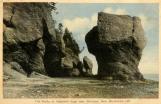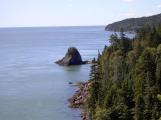1
The Aboriginal People of Albert CountyThe first known inhabitants of Albert County were the aboriginals who had settlements in this area of New Brunswick when the French arrived in 1698. Eastern New Brunswick was held by the Micmac, while the Maliseet lived along the St. John River. These two tribes were nomadic peoples who did not often build permanent settlements. Instead they hunted game during the winter at settlements deep in the wooded hills, which offered some protection from the cold. Then during the summer the native people would migrate to the rivers and the shoreline to fish.
Thus the Bay of Fundy and the rivers and creeks that empty into it were an important source of food for the Micmac. As the aboriginals often traveled by canoe, the waterways were also an important, and sometimes dangerous, mode of transportation.
Although the Micmac did not build permanent settlements there is evidence of at least two Micmac settlements in Albert County. One such Micmac settlement was on a piece of land that is now called Indian Island. The Island is a few acres of land situated on the, "northwest side of Shepody Bay to the north of the Shepody River." Although this land used to be surrounded by water, when the English settlers arrived they built dykes around the Island to expose the marshland around it; the Island then became connected to the mainland.
2
Reproduction of the William Daniel's land grant map dated 1770.19 September 1770
Shepody, New Brunswick, Canada

3
Another settlement was on the shore of Ha Ha Bay. Both of these settlements were near where the first French settlement in Albert County was founded. There is much evidence of Indian inhabitants and Indian villages in the area during the period of French settlement. However, following the expulsion of the French in 1755, the Indian inhabitants who were allies of the French, seem to have gradually disappeared. The natives who did stay in the area after the expulsion of the French also got along well with the German settlers who arrived here in 1765. Some natives in the area may have been forced to leave with the Acadians while the rest may have moved away to escape the influx of new settlers. Today there are few descendants of those Micmac peoples in the area, however, many of the legends told by those people still survive.One of those legends that still exists is the legend of Glooscap. It is told that Glooscap was a deity who lived with the Micmac in human form. He is said to have tamed the wild animals, allowing them to be hunted. According to legend Glooscap was offended at the coming of the white man and deserted his people when the first settlers arrived.
One Micmac legend explains the giant tides of the Bay of Fundy. Glooscap decided to take a bath. Seeing no water around he summoned an old beaver to get him some water. The beaver dug a trench and the water from the ocean filled it. Just as Glooscap sat down in the water a whale stuck his head into the entrance of the Bay. When Glooscap got up to leave the whale swam away. This produced the high tides which rush in and out of the bay daily.
Through their tradition of story telling, the Mi'kmaq have their own legends to explain the unique rock formations known as the flowerpot rocks.
4
Photo of the Hopewell Rocks in Hopewell Cape, Albert County.15 September 1918
Hopewell Cape, New Brunswick, Canada

5
The following are two such legends which explain the strange formations.1. The Hopewell Rocks are unfortunate Mi'kmaq who were turned into stone by angry great whales that once lived in the Bay of Fundy. Enslaved by the whales, many of the Mi'kmaq tried to escape. Just as they reached the beach, the whales transformed them into the formations that exist today.
2. There was once a fearful monster who liked to feast continually on white porpoises. Frequently, he captured natives and made them his slaves. One day he ordered these slaves to go fishing porpoises for him. As soon as they were out of sight, the slaves escaped. In his fury, the monster lashed out with his tail and churned up the cliffs into these strange shapes.
Another interesting legend explains the existence of a large mass of rock in Fundy National Park which is separated from the coast by a few feet, and becomes an island during high tide. It is known as Squaw's Cap.
6
This rock formation in Fundy National Park is known as Squaw's Cap.15 September 2003
Fundy National Park, New Brunswick, Canada
